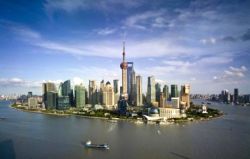Difference between revisions of "Shanghai free trade zone"
imported>Ciic m (Protected "Shanghai free trade zone" ([edit=sysop] (indefinite) [move=sysop] (indefinite))) |
imported>Ciic |
||
| Line 1: | Line 1: | ||
[[file:Shanghai free trade zone.JPEG|thumb|250px|The 28-square-km Shanghai free trade zone.]] | [[file:Shanghai free trade zone.JPEG|thumb|250px|The 28-square-km Shanghai free trade zone.]] | ||
| − | The '''Shanghai free trade zone''' ('''上海自由贸易试验区'''), a massive-scale project approved during an executive meeting of the State Council presided over by Premier [[Li Keqiang]] on July 3, 2013, will catapult the city to the forefront of global logistics centers. | + | The '''Shanghai free trade zone''' ('''上海自由贸易试验区'''), a massive-scale project approved during an executive meeting of the [[State Council]] presided over by Premier [[Li Keqiang]] on July 3, 2013, will catapult the city to the forefront of global logistics centers. |
The Shanghai free trade zone, first of its kind on the Chinese mainland, includes the special customs zones of the Yangshan Deep Water Port, Pudong Airport and Waigaoqiao Port, covering a total of 28 square kilometers. The zone will take more than 10 years to construct. Upon completion, the free trade zone will provide world-class transport and communications facilities, as well as a tax-free environment for domestic and foreign enterprises who consider Shanghai to be a major hub of their supply chains across Asia. | The Shanghai free trade zone, first of its kind on the Chinese mainland, includes the special customs zones of the Yangshan Deep Water Port, Pudong Airport and Waigaoqiao Port, covering a total of 28 square kilometers. The zone will take more than 10 years to construct. Upon completion, the free trade zone will provide world-class transport and communications facilities, as well as a tax-free environment for domestic and foreign enterprises who consider Shanghai to be a major hub of their supply chains across Asia. | ||
Revision as of 07:19, 16 July 2013
The Shanghai free trade zone (上海自由贸易试验区), a massive-scale project approved during an executive meeting of the State Council presided over by Premier Li Keqiang on July 3, 2013, will catapult the city to the forefront of global logistics centers.
The Shanghai free trade zone, first of its kind on the Chinese mainland, includes the special customs zones of the Yangshan Deep Water Port, Pudong Airport and Waigaoqiao Port, covering a total of 28 square kilometers. The zone will take more than 10 years to construct. Upon completion, the free trade zone will provide world-class transport and communications facilities, as well as a tax-free environment for domestic and foreign enterprises who consider Shanghai to be a major hub of their supply chains across Asia.
The pilot program includes several steps. It will create tax-friendly facilities for trade and investment within the free trade zone, promote China's interest-rate liberalization and, eventually, Renminbi convertibility. It will also encourage financial product innovation and promote the development of offshore businesses. The program is set to play an important part in the negotiations for the Trans-Pacific Partnership Agreement (TPP) and become the first open window to help China join the TPP.
Statistics released by the Shanghai Municipal Office for Port Services showed that Shanghai's foreign trade cargo handling capacity accumulated to 306 million tons in 2012, an increase of 5.9 percent over the same period during the previous year, ranking first in the world in terms of cargo and container management capacities.
The creation of a Shanghai free trade zone is the Chinese government's latest major initiative in adapting to global economic development trends and furthering its opening up to the outside world. It is conducive to cultivating new advantages for China in the face of global competition. Moreover, it will help build a new platform for its cooperation with other countries and regions, develop new space for economic growth and build an “upgraded version” of the Chinese economy.
